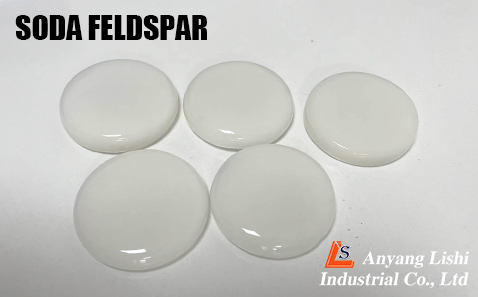
Soda feldspar, also known as sodium feldspar, is a prevalent sodium aluminosilicate mineral found abundantly in igneous and metamorphic rocks. This mineral’s significance in geology lies in its widespread occurrence and its role as a fundamental constituent in the formation of various rock types. This article explores the characteristics, formation, and geological importance of soda feldspar as a sodium aluminosilicate mineral.

Soda feldspar, represented by the chemical formula NaAlSi₃O₈, belongs to the framework silicate group, specifically the tectosilicates. The mineral’s composition includes sodium (Na), aluminum (Al), silicon (Si), and oxygen (O). Its crystal structure falls within the triclinic crystal system, often exhibiting a prismatic or tabular habit. The three-dimensional framework is formed by interconnected tetrahedra of silica (SiO₄).
Soda feldspar is a common constituent in various rock types, such as granite, syenite, and granodiorite, as well as in metamorphic rocks like schist and gneiss. The mineral typically forms during the crystallization of molten rock, or magma, as it cools. This process results in the slow growth and solidification of soda feldspar crystals alongside other minerals like quartz and mica.
The specific conditions of magma, including sodium and aluminum concentrations, play a crucial role in the formation of soda feldspar. Granitic magmas, with elevated levels of sodium and aluminum, provide a favorable environment for the crystallization of soda feldspar. The cooling rate of the magma also influences the size of the feldspar crystals, with slower cooling promoting larger crystal growth.
Soda feldspar possesses distinct physical properties, making it easily identifiable. With a hardness ranging from 6 to 6.5 on the Mohs scale, the mineral falls into the moderately hard category. Its colors span from white and gray to pink, exhibiting a vitreous to pearly luster. Perfect cleavage in two directions and a specific gravity of approximately 2.62 further characterize soda feldspar.
As a prominent component in many igneous and metamorphic rocks, soda feldspar significantly influences their mineralogical composition. In granitic rocks, it frequently coexists with quartz, plagioclase feldspar, and mica. The mineral’s presence contributes to the rock’s color, texture, and mechanical properties.
Granites, renowned for their light color, owe this characteristic to the abundance of soda feldspar. The interlocking crystals of soda feldspar and quartz create the granular texture that is distinctive to granites. Additionally, the mineral’s inclusion impacts the strength and durability of the rock.
Beyond its geological importance, soda feldspar finds extensive applications in various industries owing to its unique properties. One notable application is in the ceramics industry, where it serves as a key component in the production of glass and ceramics. Its low melting point makes soda feldspar a valuable flux, aiding in the fusion of other materials during the firing process.
In the ceramics industry, 200 mesh sodium feldspar is often used as a flux in the production of ceramic materials. A flux is a substance that promotes the melting of other materials, and sodium feldspar is known for its ability to lower the melting temperature of ceramic materials. This property is particularly useful in the production of glazes and glass. Sodium feldspar is also used as a filler in the manufacturing of ceramics to enhance certain properties of the final product.

Soda feldspar emerges as a significant sodium aluminosilicate mineral, widely distributed in the Earth’s crust. Its pivotal role in the formation of diverse rock types, coupled with its applications in industries like ceramics and glassmaking, underscores its geological and economic importance. As scientists continue to unravel the complexities of the Earth’s composition, soda feldspar remains a captivating subject, bridging the gap between geological processes and advancements in human technology.

Whether you have questions or you would just like to say hello,Contact us!
Call Anytime:
+86 15837207537Send E-mail:
info@lsakminerals.comAddress:
Anyang City , Henan Province, China.